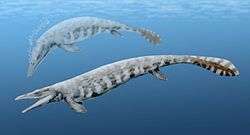Halisaurinae
| Halisaurinae Temporal range: Late Cretaceous | |
|---|---|
 | |
| Halisaurus | |
| Scientific classification | |
| Kingdom: | Animalia |
| Phylum: | Chordata |
| Class: | Sauropsida |
| Suborder: | Scleroglossa |
| Infraorder: | Anguimorpha |
| Family: | Mosasauridae |
| Subfamily: | Halisaurinae Bardet et al., 2005 [1] |
| Genera | |
Halisaurinae [1] is a subfamily of mosasaurs, a diverse group of Late Cretaceous marine squamates.
Bardet et al. (2005, p. 464[1]) diagnosed the Halsaurinae as all mosasaurs more closely related to Halisaurus than Moanasaurus. Unambiguous character states were listed as follows: "premaxilla-maxilla sutural contact vertical anteriorly, oblique at midpoint and horizontal posteriorly; contact plane between the parietal and the supratemporal oblique; preaxial ridge extending on two-thirds of the length of the radius; tibia and fibula long and slender with slightly expanded extremities. Ambiguous characters include "dorsal median ridge borne on the anterior two-thirds of the frontal; frontal with ventral boss; parietal foramen surrounded by a ventral boss; quadrate with large infrastapedial process; coalescent infra- and suprastapedial processes of quadrate; zygosphene-zygantrum complex absent; synapophyses of the cervical vertebrae extending ventrally to the ventral surface of the centrum; fused haemal spines."
Designation of this subfamily followed many decades of confusion surrounding the type genus, Halisaurus, especially H. sternbergii, a species from the Mooreville Chalk Formation of Alabama and the Niobrara Chalk of Kansas. Originally, the species had been referred to the mosasaurine Clidastes,[2] then to Halisaurus (Russell, 1967; p. 369 [3]), which was also considered a member of the Mosasaurinae at that time. Later workers [4][5] questioned the phylogenetic position and monophyly of Halisaurus, in part because of striking morphological differences between H. sternbergii and the other known species of the taxon. Finally, Bardet et al. (2004) determined that H. sternbergii was not conspecific with the other members of the genus and erected a new genus, Eonatator, as well a new subfamily, consisting of Eonatator and Halisaurus. Halisaurines (as members of this subfamily are collectively and informally known) were small to medium-sized mosasaurs averaging 4.5-6+ meters in length. Of all known mosasaurids, they were the least adapted to a marine lifestyle. Halisaurines are known from North America, Europe, South America, and Africa. The earliest known remains of halisaurines occur in rocks of Santonian age and the subfamily persists until the latest Maastrichtian. The etymology of this group derives from the genus Halisaurus (Greek halis = "sea" + Greek sauros = "lizard").
Phylogeny and Taxonomy
Halisaurus is an important taxon in studies of mosasaur phylogeny as it has been repeatedly considered the sister group to all other mosasaurs. A cladistic analysis by Bardet et al. (2005, p. 462-463 [1] ) supported this model and the clade composed of Halisaurus and Eonatator was christened the Halisaurinae, "the sister group of more advanced mosasaurids."
- Halisaurinae
- Halisaurus
- H. platyspondylus
- H. ortlebi
- H. arambourgi
- H. onchognathus (nomen dubium; holotype destroyed during World War II)
- Eonatator
- E. sternbergii
- Halisaurus
References
- 1 2 3 4 Bardet N, Suberbiola XP, Iarochene M, Bouyahyaoui F, Bouya B, Amaghzaz M. 2005. A new species of Halisaurus from the Late Cretaceous phosphates of Morocco, and the phylogenetical relationships of the Halisaurinae (Squamata: Mosasauridae). Zoological Journal of the Linnean Society 143: 447-472.
- ↑ Wiman CJ. 1920. Some reptiles from the Niobrara group in Kansas. Bulletin of the Geological Institute of Uppsala 18: 9-18 (9 figs., pls. II-IV).
- ↑ Russell DA. 1967. Systematics and morphology of American mosasaurs. Peabody Museum of Natural History, Yale University, Bulletin 23.
- ↑ Wright KR. 1988. A new specimen of Halisaurus platyspondylus (Squamata: Mosasauridae) from the Navesink Formation (Maastrichtian) of New Jersey. Journal of Vertebrate Paleontology 8 (Supplement 3): 29A-30A.
- ↑ Bell GL. Jr. 1997. A phylogenetic revision of North American and Adriatic Mosasauroidea. pp. 293-332 In: Callaway JM. and Nicholls EL, (eds.), Ancient Marine Reptiles, Academic Press: 501 pp.
Further reading
Bardet N, Suberbiola XP. 2001. The basal mosasaurid Halisaurus sternbergii from the Late Cretaceous of Kansas (North America): a review of the Uppsala type specimen. Comptes Rendus de l'Academie des Sciences - Series IIA - Earth and Planetary Science 332: 395-402.